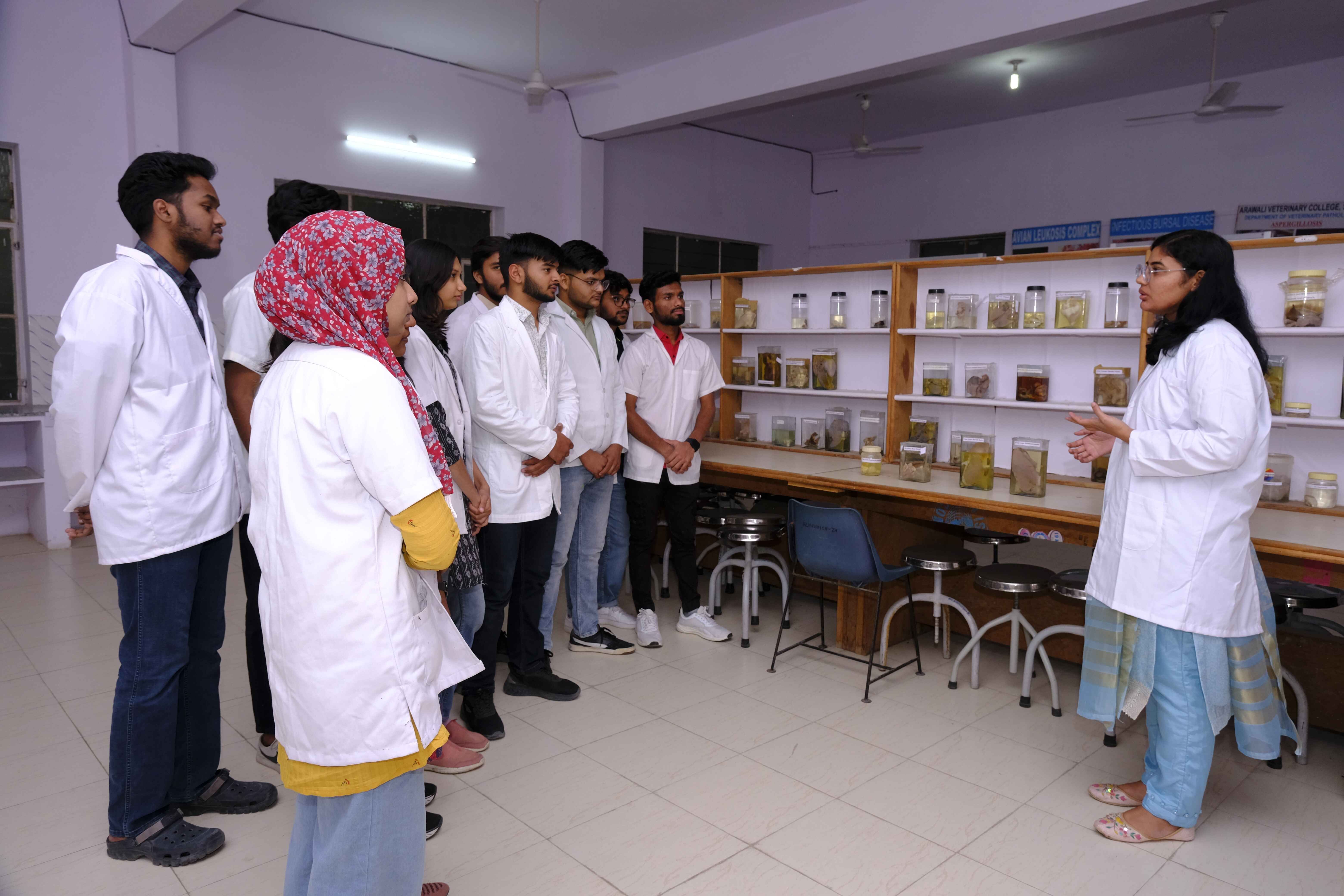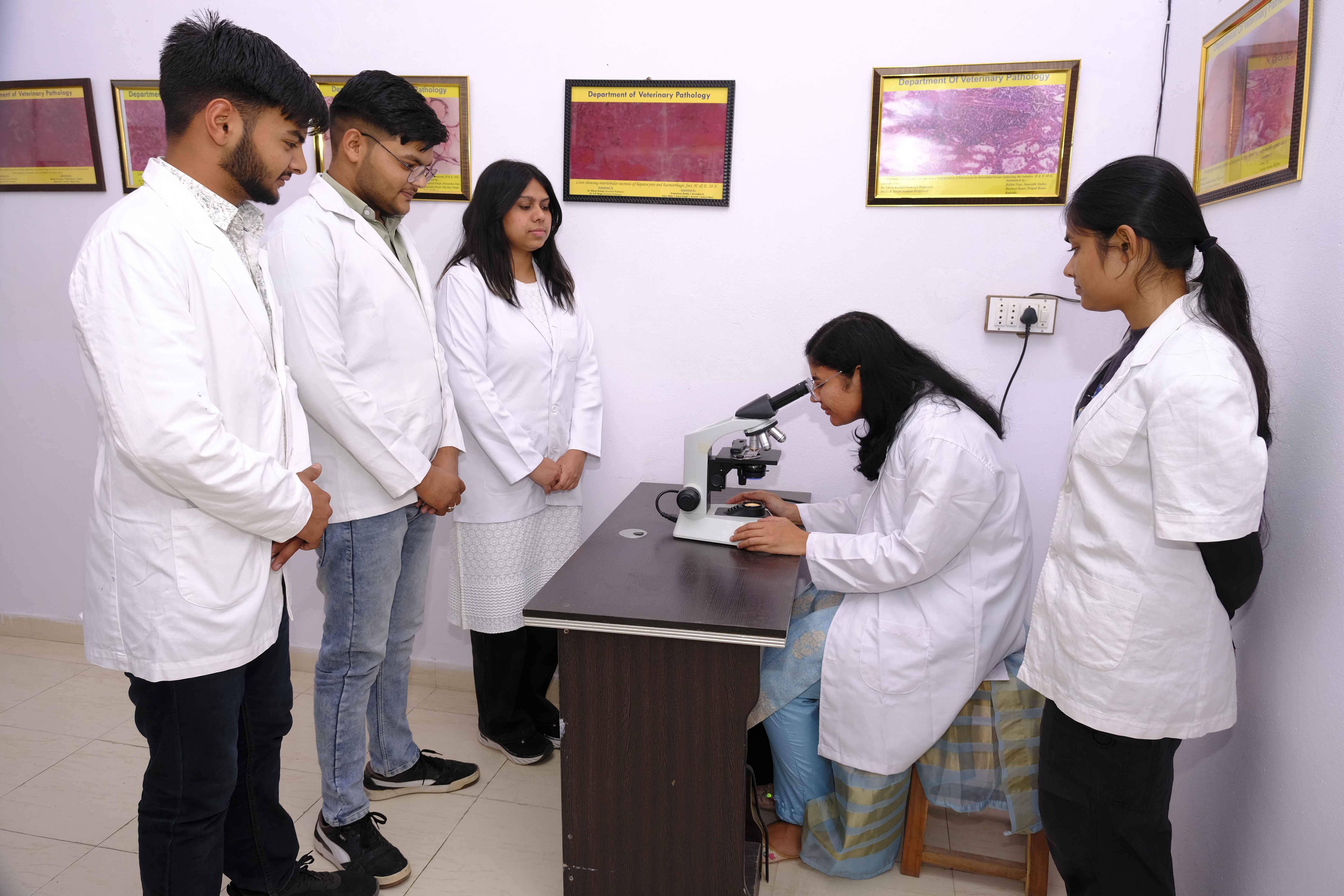

Department of Veterinary Pathology: Success of treartment of an ailment depends upon the knowledge of etiology and diagnosis of disease. Mandate of the department is to teach pathology of disease progression and practical training for identification of gross lesions, histopathological, microscopic and clinical post mortem examinations for diagnosis of diseases in animals. The department is well equipped with microtome, automatic tissue processor, microscope and a clinical pathology laboratory.
The Department has following sanctioned strength of Faculty:
Professor - 1
Associate Professor – 1
Assistant Professors – 2
COURSE AND SYLLABI
| S.No. |
Name |
Designation |
Qualification |
Service Period at AVC |
Photo |
Biodata |
|
01
|
Dr. Apurba Chakraborty
|
Professor
|
B.V.Sc & AH, M.V.Sc and PhD
|
01.06.2021 to till Continue
|
 |
|
|
02
|
Dr. Hiteshwar Singh Yadav
|
Assistant Professor
|
B.V.Sc & AH, M.V.Sc
and PhD
|
13.05.2024 to till Continue
|
 |
Biodata |
|
03
|
Dr. Pushpendra Chawla Khatik
|
Assistant Professor
|
B.V.Sc & AH, M.V.Sc
|
20.08.2024 to till Continue
|
 |
Biodata |
|
04
|
Dr Vishnubashini I |
Assistant Professor
|
B.V.Sc & AH, M.V.Sc
|
01.11.2025 to till Continue
|
|
Biodata |
| |
|
|
|
|
|
|
THEORY
UNIT-1 (GENERAL VETERINARY PATHOLOGY)
Introduction and scope of Veterinary Pathology. Major intrinsic and extrinsic causes of disease. Haemodynamic disorders (hyperaemia, congestion, haemorrhage, oedema, thrombosis, embolism and infarction). Glycogen overload, amyloidosis and fatty changes. Reversible and irreversible cell injury- degenerations, necrosis and its types, apoptosis, differences between post-mortem autolysis and necrosis, gangrene and its types. Major exogenous and endogenous pigments. Metastatic and dystrophic calcification. Photosensitization. Disturbances in growth (Aplasia, hypoplasia, atrophy, hypertrophy, hyperplasia, metaplasia and dysplasia). Inflammation: Definitions, classification, various cell types and their functions, mediators, cardinal signs and systemic effects. Wound healing by primary and secondary intention including growth factors. Immunopathology in brief (immunodeficiency, hypersensitivity and autoimmunity).
UNIT-2 (SYSTEMIC VETERINARY PATHOLOGY)
Pathological changes affecting Digestive, Respiratory, Musculoskeletal, Cardiovascular, Haematopoietic, Lymphoid, Urinary, Reproductive, Nervous, Endocrine systems, Skin and Appendages, Ear and Eye.
UNIT-3 (ANIMAL ONCOLOGY, VETERINARY CLINICAL PATHOLOGY AND NECROPSY)
Animal Oncology: Definitions, general characteristics and classification of neoplasms. Differences between benign and malignant tumours, aetiology, carcinogenesis and spread of neoplasms, tumour immunity, effects and diagnosis of tumours, staging and grading of neoplasms. Pathology of various types of tumours in domestic animals (epithelial, connective tissue, hematopoietic tissue etc.) Veterinary Clinical Pathology: Introduction, Haematology – Different anticoagulant used in haematology, interpretation of blood tests (haemoglobin, packed cell volume, total erythrocyte count, erythrocytic indices, erythrocytic sedimentation rate, total leukocyte count, absolute count of different leucocytes), blood smear examination and its interpretation. Urinalysis- Interpretation of physical, chemical and microscopic examination of urine. Study of biopsy and cytology including exfoliative cytology as rapid diagnostic techniques. Necropsy: Introduction, objectives, pre-necropsy guidelines, procedure for post mortem examination of various species of animals including wild animals, post mortem changes, collection, preservation and dispatch of specimens (morbid materials) for laboratory examination, writing of post mortem report, veterolegal necropsy , veterolegal wounds.
UNIT-4 (PATHOLOGY OF INFECTIOUS AND NON-INFECTIOUS DISEASES OF DOMESTIC ANIMALS)
Pathology of viral infections: Pathogenesis, gross and microscopic pathology of foot and mouth disease,Rinderpest, malignant catarrhal fever, blue tongue, Infectious bovine rhinotracheitis, bovine viral diarrhoea, Peste des Petitis (PPR), equine infectious anaemia, equine influenza, equine viral arteritis, equine rhinopneumonitis, classical swine fever, swine influenza, rabies, canine distemper, infectious canine hepatitis, canine parvovirus infection, feline panleukopenia, maedi, jaagziekte, pox virus diseases in different animals. Vesicular stomatitis, vesicular exanthema, equine encephalomyelitis, diseases caused by rota and corona viruses. Pathology of prion diseases (scrapie, bovine and feline spongiform encephalopathies). Pathology of bacterial infections: Pathogenesis, gross and microscopic pathology of tuberculosis, Johne's disease, actinomycosis, actinobacillosis, anthrax, clostridial group of diseases (black quarter, black disease, enterotoxaemia, braxy, botulism tetanus), streptococosis including strangles in horses, staphylococosis, glanders, pasteurellosis, leptospirosis, listeriosis, swine erysipelas, brucellosis, corynebacterium infections (caseous lymphadenitis, pseudotuberculosis), campylobacteriosis, salmonellosis, and colibacillosis including oedema disease in pigs, and necrobacillosis). Pathogenesis, gross and microscopic pathology of mycoplasma infection (contagious bovine pleuropneumonia, contagious caprine pleuropneumonia, porcine enzootic pneumonia), diseases of chlamydial group, Q-fever, anaplasmosis and ehrlichiosis. Pathogenesis, gross and microscopic pathology of superficial and deep mycoses - ringworm (dermatophytosis), aspergillosis, zygomycosis, histoplasmosis, cryptococosis, rhinosporidiosis and candidiasis. Pathogenesis, gross and microscopic pathology of aflatoxicosis, ochratoxicosis, trichothecosis, Degnala disease and ergotoxicosis. Pathogenesis, gross and microscopic pathology of fasciolosis, babesiosis, theileriosis and trypanosomosis. Pathological changes (in brief) of amphistomiasis, ascariasis, Strongylosis, haemonchosis, spirocercosis, filariasis, hookworm, tapeworm infections, coccidiosis, toxoplasmosis, cryptosporidiosis, Pathological changes of nutritional imbalances (in brief) due to carbohydrates, proteins, fats, minerals and vitamins and metabolic diseases (pregnancy toxaemia, post-parturient haemoglobinuria, hypomagnesemic tetany, azoturia, and sway backorenzootic ataxia, pica and Rheumatism like syndrome). Gross and microscopic pathologyin (brief) of toxicities like arsenic, copper, lead, mercury, cadmium, strychnine, nitrateornitrite, hydrocyanic acid, fluoride, selenium and oxalates; insecticideorpesticide poisoning, plant poisoning (braken fern, gossypol, ratti and lantana)
UNIT-5 (AVIAN PATHOLOGY)
Avian Inflammation, Viral Diseases: Pathogenesis, gross and microscopic pathology of Ranikhet disease, infectious bursal disease, infectious bronchitis, infectious laryngotracheitis, fowl pox, avian influenza, Marek's disease, leukosisorsarcoma group of diseases, reticuloendotheliosis, avian encephalomyelitis, inclusion body hepatitis, hydropericardium syndrome, chicken infectious anaemia, avian nephritis, egg drop syndrome, reovirus infections. Bacterial Diseases: Pathogenesis, gross and microscopic pathology of colibacillosis, infectious coryza, clostridial diseases, salmonella infections, fowl cholera, tuberculosis and spirochaetosis. Pathogenesis, gross and microscopic pathology of Mycoplasma infections, chlamydiosis. Pathogenesis, gross and microscopic pathology of aspergillosis, thrush, favus, aflatoxicosis, ochratoxicosis and trichothecosis. Gross and microscopic pathology (in brief) of helminthic diseases (flukes, cestodes, nematodes), protozoal diseases (coccidiosis, histomoniasis), ectoparasites. Gross and microscopic pathology of nutritional imbalances due to carbohydrates, proteins, minerals and vitamins. Miscellaneous diseases (Heat stroke, vent gleet, internal layer, false layer, pendulous crop, breast blister, ascites syndrome, fatty liver and kidney syndrome, fatty liver syndrome, cage layer fatigue, gout, hemorrhagic syndrome, round heart disease, impaction of oviduct, egg bound condition, bumble foot) and common vices.
UNIT-6 (PATHOLOGY OF DISEASES OF LABORATORY AND WILD ANIMALS)
Pathology of important diseases of rats, mice, and guinea pigs (Tyzzer’s disease, Pseudotuberculosis, Salmonellosis, Infectious ectromelia, Infantile diarrhea, murine hepatitis virus, Lymphocytic choriomeningitis); Pathology of important diseases of rabbits (Pasteurellosis, Blue breasts, Treponematosis, Enterotoxaemia, Rabbit pox , Infectious myxomatosis, Papillomatosis , Coccidiosis, Mite infestation). Gross and microscopic pathology of important diseases of wild animals (West Nile Fever, Rabies, FMD, Pox, Kyasanaur forest disease, Infectious hepatitis virus, Anthrax, Tuberculosis, Colibacillosis, Clostridial infections rypanosomosis, Babesiosis, Theileriosis, Nutritional deficiency diseases)
PRACTICAL
UNIT-1 (GENERAL VETERINARY PATHOLOGY)
Study of gross pathological specimens and recognition of pathological lesions. Histopathological techniques– Processing of tissue for paraffin embedding technique, section cutting, staining and identification of microscopic lesions. Examination of histopathological slides showing general pathological alterations.
UNIT-2 (SYSTEMIC VETERINARY PATHOLOGY)
Study of gross specimens and histopathological slides pertaining to systemic pathology.
UNIT-3 (ANIMAL ONCOLOGY, VETERINARY CLINICAL PATHOLOGY AND NECROPSY
Macroscopic and microscopic examinations of various types of benign and malignant tumours. Examination of blood for routine haematological tests in domestic animals and poultry. Physical, chemical and microscopic examination of urine. Post mortem examination of different species of animals including wild and laboratory animals.
UNIT-4 (PATHOLOGY OF INFECTIOUS AND NON-INFECTIOUS DISEASES OF DOMESTIC ANIMALS)
Post mortem examination and its interpretations, Study of gross specimens and histopathological slides of various organs pertaining to infectious and non- infectious diseases of domestic animals. Demonstration of causative agents in tissue section by special staining methods and use of rapid diagnostic tests.
UNIT-5 (AVIAN PATHOLOGY)
Post mortem examination of poultry and writing of post mortem report. Collection, preservation and dispatch of morbid materials in poultry diseases. Study of gross specimens and histopathological slides of different diseases of poultry.
UNIT-6 (PATHOLOGY OF DISEASES OF LABORATORY AND WILD ANIMALS)
Post mortem examination of laboratory and wild animals. Study of gross specimen and histopathological slides of diseases affecting laboratory and wild animals.
ANNUAL EXAMINATION
PAPERS UNITS MAXIMUM MARKS WEIGHTAGE
THEORY
Paper-I 1, 2 and 3 100 20
Paper-II 4, 5 and 6 100 20
PRACTICAL
Paper-I 1, 2 and 3 60 20
Paper - II 4, 5 and 6 60 20
INTERNAL ASSESSMENT 20